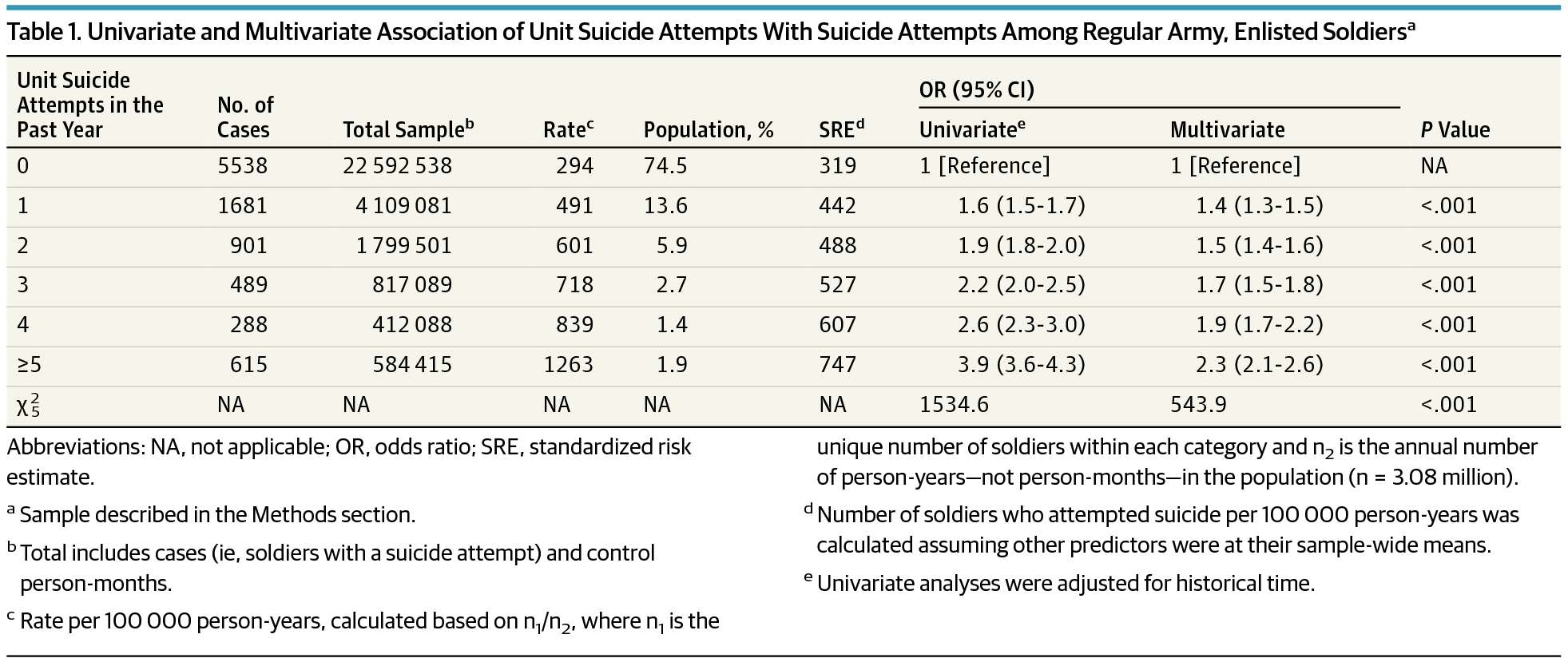JAMA Psychiatry ( IF 25.8 ) Pub Date : 2017-09-01 , DOI: 10.1001/jamapsychiatry.2017.1925 Robert J. Ursano 1 , Ronald C. Kessler 2 , James A. Naifeh 1 , Holly Herberman Mash 1 , Carol S. Fullerton 1 , Paul D. Bliese 3 , Alan M. Zaslavsky 2 , Tsz Hin Hinz Ng 1 , Pablo A. Aliaga 1 , Gary H. Wynn 1 , Hieu M. Dinh 1 , James E. McCarroll 1 , Nancy A. Sampson 2 , Tzu-Cheg Kao 4 , Michael Schoenbaum 5 , Steven G. Heeringa 6 , Murray B. Stein 7 ,

|
Importance Mental health of soldiers is adversely affected by the death and injury of other unit members, but whether risk of suicide attempt is influenced by previous suicide attempts in a soldier’s unit is unknown.
Objective To examine whether a soldier’s risk of suicide attempt is influenced by previous suicide attempts in that soldier’s unit.
Design, Setting, and Participants Using administrative data from the Army Study to Assess Risk and Resilience in Servicemembers (STARRS), this study identified person-month records for all active-duty, regular US Army, enlisted soldiers who attempted suicide from January 1, 2004, through December 31, 2009 (n = 9650), and an equal-probability sample of control person-months (n = 153 528). Data analysis was performed from August 8, 2016, to April 10, 2017.
Main Outcomes and Measures Logistic regression analyses examined the number of past-year suicide attempts in a soldier’s unit as a predictor of subsequent suicide attempt, controlling for sociodemographic features, service-related characteristics, prior mental health diagnosis, and other unit variables, including suicide-, combat-, and unintentional injury–related unit deaths. The study also examined whether the influence of previous unit suicide attempts varied by military occupational specialty (MOS) and unit size.
Results Of the final analytic sample of 9512 enlisted soldiers who attempted suicide and 151 526 control person-months, most were male (86.4%), 29 years or younger (68.4%), younger than 21 years when entering the army (62.2%), white (59.8%), high school educated (76.6%), and currently married (54.8%). In adjusted models, soldiers were more likely to attempt suicide if 1 or more suicide attempts occurred in their unit during the past year (odds ratios [ORs], 1.4-2.3; P < .001), with odds increasing as the number of unit attempts increased. The odds of suicide attempt among soldiers in a unit with 5 or more past-year attempts was more than twice that of soldiers in a unit with no previous attempts (OR, 2.3; 95% CI, 2.1-2.6). The association of previous unit suicide attempts with subsequent risk was significant whether soldiers had a combat arms MOS or other MOS (ORs, 1.4-2.3; P < .001) and regardless of unit size, with the highest risk among those in smaller units (1-40 soldiers) (ORs, 2.1-5.9; P < .001). The population-attributable risk proportion for 1 or more unit suicide attempts in the past year indicated that, if this risk could be reduced to no unit attempts, 18.2% of attempts would not occur.
Conclusions and Relevance Risk of suicide attempt among soldiers increased as the number of past-year suicide attempts within their unit increased for combat arms and other MOSs and for units of any size but particularly for smaller units. Units with a history of suicide attempts may be important targets for preventive interventions.
中文翻译:

有自杀未遂史的陆军士兵中自杀未遂的风险
重要性 士兵的心理健康会受到其他部队成员的伤亡的不利影响,但是尚不清楚自杀企图的风险是否受到先前士兵部队自杀企图的影响。
目的 研究士兵的自杀未遂风险是否受到该士兵单位先前的自杀未遂影响。
设计,设置和参与者 利用陆军研究的管理数据评估在役人员的风险和抵御能力(STARRS),该研究确定了自1月1日起尝试自杀的所有现役美军正规兵入伍士兵的人月记录。 2004年至2009年12月31日(n = 9650),以及控制人月的等概率样本(n = 153 528)。数据分析于2016年8月8日至2017年4月10日进行。
主要结果和衡量指标 Logistic回归分析检查了士兵部队过去一年的自杀未遂次数,以此作为随后自杀未遂的预测指标,控制了社会人口统计学特征,服务相关特征,先前的精神健康诊断以及其他单位变量,包括自杀-,与战斗和意外伤害相关的单位死亡。该研究还检查了以前的单位自杀企图的影响是否因军事职业专业(MOS)和单位规模而异。
结果 在9512名自杀未遂士兵和151 526个控制人月的最终分析样本中,大多数是男性(86.4%),29岁或更年轻(68.4%),入伍年龄小于21岁(62.2%)。 ,白人(59.8%),高中学历(76.6%)和目前已婚(54.8%)。在调整后的模型中,如果在过去的一年中单位内发生1次或多次自杀未遂,则士兵更容易自杀(赔率[OR]为1.4-2.3;P <.001),并且随着单位尝试次数的增加,赔率也随之增加。过去一年中有5次或更多次尝试的单位中士兵自杀未遂的几率是以前没有尝试过的单位士兵中自杀未遂的几率的两倍(OR,2.3; 95%CI,2.1-2.6)。以前的单位自杀未遂与随后的风险之间的相关性非常显着,无论士兵是使用战斗武器的MOS还是其他MOS(OR,1.4-2.3;P <.001),并且无论单位大小如何,在较小单位中,自杀风险最高( 1至40名士兵)(OR,2.1-5.9;P <.001)。在过去的一年中,一次或多次单位自杀未遂的人口归因风险比例表明,如果可以将这一风险降低到无单位未遂,则不会发生18.2%的未遂尝试。
结论与相关性 随着作战部队和其他MOS以及任何规模(尤其是规模较小的单位)的部队中过去一年自杀未遂次数的增加,士兵中自杀未遂的风险也有所增加。有自杀未遂史的单位可能是预防干预措施的重要目标。



























 京公网安备 11010802027423号
京公网安备 11010802027423号